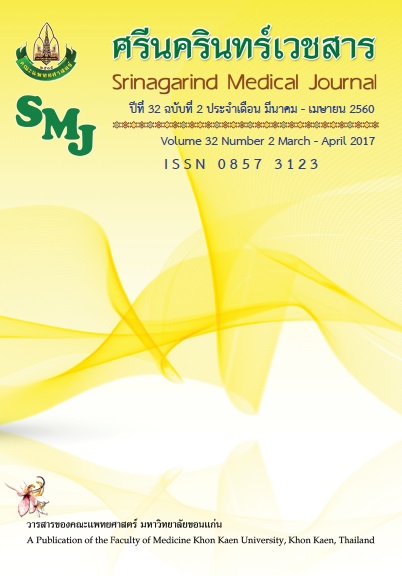A Development and Evaluation of Clinical Nursing Practice Guideline for Obese Patient Undergoing General Anesthesia at Songklanakarind Hospital
Keywords:
Clinical practice nursing guideline, obese patients, general anesthesia, แนวปฏิบัติทางการพยาบาลผู้ป่วยโรคอ้วน, การระงับความรู้สึกแบบทั่วตัวAbstract
Background and Objectives : The obese patients undergoing general anesthesia are risk for complications such as hypoxemia or airway obstruction during intra- and post-anesthesia. This study aimed to develop the clinical nursing practice guideline (CNPG) for obese patients undergoing general anesthesia and to evaluate the outcomes of the implemented CNPG .
Methods: This Development Research has developed a CNPG based on the principles and guidelines from the National Health and Medical Research Council of Australia. The contents of the CNPG were validated and approved by five experts. The clinical outcomes and satisfaction were evaluated from the nurse anesthetists who implemented the CNPG in 35 patients. The tools for data collection include the operative care records collected at preoperative evaluation, intraoperative, and postoperative anesthesia care, and the satisfaction questionnaire from the nurse anesthetists as a CNPG user. Data were then analyzed by the descriptive statistics.
Results: The CNPG developed for the obese patients who were undergoing general anesthesia for surgery consisted of three stages: preoperative evaluation, intraoperative, and postoperative anesthesia care. The evaluation of the CNPG implementation from the nurse anesthetists showed the satisfaction level at 8.29 (from 0 to 10 scale). According to the clinical outcomes, only one patient developed, hypoxemia, in the postoperative anesthesia care unit, which was solved by giving oxygen. Oxygen was then given continuously to the patient at the ward. No incidence of airway obstruction was found in every patient during intraoperativeand postoperative anesthesia care, during transfer tothe recovery room, or in the recovery room. Most of obese patients had obstructive sleep apnea (OSA) and used CPAP before having the surgery. At the ward after surgery, 25.7% of the patients was found with OSA at night and used CPAP.
Conclusion: The CPNG was clear and easy for implementation. The guideline covered all three stages of the anesthesia including preoperative evaluation, intraoperative, and postoperative anesthesia care. This provided the same standard for every patient and improved the quality in nursing. Nurse anesthetists's suggest for improving the CNPG by adding a part of CPAP in the preoperative information.
การพัฒนาและประเมินผลการใช้แนวปฏิบัติทางคลินิกการพยาบาลสำหรับผู้ป่วยโรคอ้วนที่ได้รับการระงับความรู้สึกแบบทั่วตัวในโรงพยาบาลสงขลานครินทร์
หลักการและวัตถุประสงค์ : ผู้ป่วยโรคอ้วนที่ได้รับการระงับความรู้สึกมีโอกาสเกิดภาวะแทรกซ้อนระบบทางเดินหายใจที่สำคัญ ได้แก่ ภาวะพร่องออกซิเจนในเลือด ภาวะอุดกั้นทางเดินหายใจระหว่างและหลังให้ยาระงับความรู้สึก ได้มากกว่าคนทั่วไป การศึกษานี้จึงมีวัตถุประสงค์เพื่อพัฒนาแนวปฏิบัติทางการพยาบาลในการดูแลผู้ป่วยโรคอ้วนที่มารับการผ่าตัดและได้รับยาระงับความรู้สึกแบบทั่วตัว และเพื่อประเมินผลลัพธ์ทางคลินิกในผู้ป่วยที่ได้รับการดูแลตามแนวปฏิบัติ ได้แก่ อุบัติการณ์ภาวะแทรกซ้อนระบบทางเดินหายใจ ได้แก่ ภาวะพร่องออกซิเจน ภาวะอุดกั้นทางเดินหายใจและประเมินผลความพึงพอใจของวิสัญญีพยาบาลผู้ใช้แนวปฏิบัติ
วิธีการศึกษา : เป็นการศึกษาเชิงพัฒนา (Development Research) การพัฒนาแนวปฏิบัติโดยประยุกต์ใช้ขั้นตอนการพัฒนาแนวปฏิบัติทางคลินิกของสภาการวิจัยทางการแพทย์และสุขภาพแห่งชาติของประเทศออสเตรเลียผ่านการตรวจสอบตามเนื้อหาโดยผู้ทรงคุณวุฒิ 5 ท่าน ประเมินผลลัพธ์ทางคลินิก และความพึงพอใจจากวิสัญญีพยาบาลผู้ใช้แนวปฏิบัติในผู้ป่วย 35 ราย และ เครื่องมือที่ใช้ในการเก็บรวบรวมข้อมูล เป็นแบบบันทึกการดูแลผู้ป่วยเมื่อนำแนวปฏิบัติไปใช้ก่อน ระหว่างและหลังการให้ยาระงับความรู้สึก แบบสอบถามความพึงพอใจของวิสัญญีพยาบาลผู้ใช้แนวปฏิบัติ การวิเคราะห์ใช้สถิติเชิงบรรยาย
ผลการศึกษา: พบว่าแนวปฏิบัติการพยาบาลในการดูแลผู้ป่วยโรคอ้วนที่มาผ่าตัดและได้ยาระงับความรู้สึกแบบทั่วตัวที่ได้ พัฒนาขึ้นประกอบด้วย 3 ระยะ คือระยะก่อน ระหว่างและหลังให้ยาระงับความรู้สึกส่วนการประเมินการนำแนวปฏิบัติไปใช้โดยวิสัญญีพยาบาลมีระดับคะแนนความพึงพอใจเฉลี่ย 8.29 (0-10) ผลลัพธ์ทางคลินิกด้านผู้ป่วย พบผู้ป่วยเพียง 1 รายที่มีภาวะแทรกซ้อน ภาวะพร่องออกซิเจน ในระยะหลังการผ่าตัดและการให้ยาระงับความรู้สึกที่ห้องพักฟื้นและสามารถแก้ไขภาวะดังกล่าวโดยการให้ออกซิเจน และให้ออกซิเจนต่อเนื่องที่หอผู้ป่วย ไม่พบภาวะแทรกซ้อนของการอุดกั้นทางเดินหายใจในระยะระหว่างและหลังให้ยาระงับความรู้สึก ช่วงส่งต่อมายังห้องพักฟื้นและที่ห้องพักฟื้นในผู้ป่วยทุกราย และ หลังผ่าตัดที่หอผู้ป่วย ร้อยละ 25.7 มีภาวะอุดกั้นทางเดินหายใจขณะนอนหลับ (OSA) ช่วงกลางคืนและมีการใช้ CPAP ช่วงนอนหลับทุกราย
สรุป: แนวปฏิบัติมีขั้นตอนที่ชัดเจนง่ายต่อการการนำไปใช้มีความครอบคลุมการดูแลทั้งก่อน ระหว่างและหลังให้ยาระงับความรู้สึกช่วยให้ผู้ป่วยได้รับการดูแลที่เป็นมาตรฐานเดียวกันและเพิ่มคุณภาพการดูแลผู้ป่วย ควรพัฒนาแนวปฏิบัติให้ครอบคลุมการให้คำแนะนำแก่ผู้ป่วยและญาติใน การฝึกใช้เครื่อง CPAP ให้ชำนาญก่อนผ่าตัด




